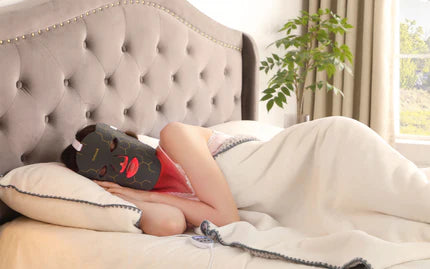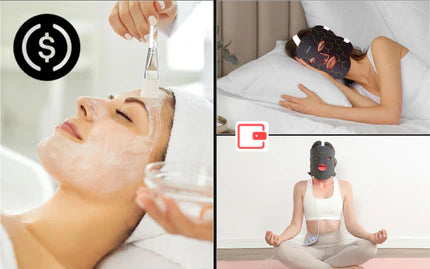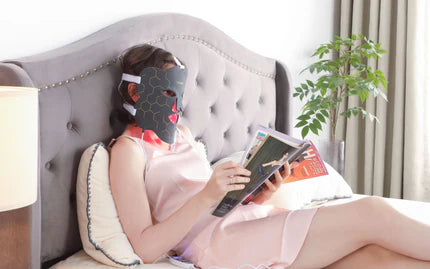If you're tired of the constant battle with sinus issues, there's a surprisingly simple solution that might just be what you're looking for: light therapy. At the flick of a switch, both red and blue light therapy has given a home-based remedy to bring some much-needed relief for those frustrating sinus symptoms-a headache and a blocked noses being just two. It's all about using special lights to reduce inflammation and kill bacteria-and it's as easy as sitting back and letting the light do its work. We will discuss how these two kinds of light can really benefit your sinus health by unpacking the science behind it and demonstrating how this technique can be safely added to your daily routine.
Understanding Sinusitis and Related Problems
Sinusitis is an inflammation of your sinuses, which are air-filled spaces in the bones around your nose. When these spaces swell up, they cause pain and pressure in your head, making it feel like you have a tight mask on. Other symptoms may include headaches, soreness around the face, stuffy nose, and at times even coughing, fatigue, and a rise in temperature.
What Causes Sinus Problems?
Sinus problems can be triggered by various factors, including catching a cold, having allergies, or experiencing changes in the weather. If smoke, pollution, or any other irritant impacts your nose, this is another way of developing sinus trouble. Also, if the inside structure of your nose is not straight (deviated septum), this can make you more prone to problems with your sinuses.
The Usual Fixes
So, what do most folks do about it? They usually hit up the pharmacy for decongestants to clear the traffic jam in their nose, pain relievers to ease the ache, or antibiotics if a doctor thinks an infection's behind it. Some might need allergy meds or even a trip to an ENT (ear, nose, and throat specialist) for more help.
Why Look Beyond the Medicine Cabinet?
Now, while these treatments can work wonders, they're not perfect. Decongestants might leave you feeling jittery, and over time, they might not work as well. Pain relievers are great, but they're like putting a band-aid on a leaky pipe-they don't fix the underlying issue. And antibiotics? They're only useful if bacteria are causing your sinus troubles, plus there's always the talk about bacteria getting resistant to them. That's why folks are peeking over the fence to see if the grass is greener with alternative approaches like light therapy-something that can possibly keep those sinus blues at bay without having to pop a pill.
Red Light Therapy for Sinus Relief
Red light therapy is the process by which these wavelengths of red light, typically between 630-700 nanometers, penetrate through the skin surface and deep into tissues. Basically, this non-invasive mechanism works in the light of nature's healing properties but without exposing the body to harmful UV rays. Its ability to treat a wide range of conditions - from skin health to muscle repair, as well as alleviating discomfort associated with sinus issues -and popularity.
How Red Light Therapy Aids Sinus Relief
For individuals suffering from sinus issues, red light therapy can be particularly beneficial. Here's how:
- Inflammation Reduction: The therapy works by reducing inflammation in the nasal passages and sinus cavities. This effect can decrease the blockage and congestion often associated with sinusitis.
- Circulation Enhancement: Improved circulation from red light therapy increases the flow of blood to the sinuses. This enhancement promotes healing and can help clear the sinuses more effectively.
- Cellular Regeneration: Exposure to red light can stimulate cells to regenerate and repair themselves. For sinuses, this means that the damaged or irritated lining of the sinus cavities can heal more efficiently, potentially reducing the frequency and severity of sinus infections.
Implementing Red Light Therapy Masks at Home
To incorporate red light therapy into your home care routine for sinusitis relief using masks, consider the following steps:
- Choose the Right Mask: Do some research on different models of red light therapy masks. Look for those intended for facial applications that produce the right spectrum of red light effective in treating sinusitis.
- Understand the Specifications: Be aware of the milliwatts, which is the light intensity; recommended distances that should be between the face and the device, among other specifications, before purchasing.
- Read and Follow Instructions: Once you have your mask, ensure you have gone through the instruction manual for proper guidance on how to use it. Check if there are any safety warnings or contraindications.
- Prepare for Treatment: Wash your face and remove as much light-reflecting makeup or skincare as possible. Find a comfortable seated or lying position in a place where you will not be disturbed.
- Duration and Frequency: Adhere to the recommended duration for each therapy session-often 15 to 20 minutes. Consistency is key, so aim to use the mask regularly, most suggest two to three times a week, to maintain the benefits.
- Aftercare: Apply any after-products as recommended by the mask manufacturer or your dermatologist following the mask's use.
- Monitor Your Sinuses: Keep a record of any change in sinus condition. Improvement in sinus pressure or a decrease in infections could serve as an indication that the treatment is working.
- Consult Healthcare Providers: If you're unsure about starting red light therapy, seek advice from a healthcare provider. They can offer guidance based on your specific sinus condition and overall health.
By incorporating red light therapy into your routine, you may find a reduction in sinus symptoms and an improvement in your general sinus health.
Blue Light Therapy for Sinus Health
Blue light therapy, similar to red light therapy, is a treatment that employs non-invasive light for therapeutic purposes. Blue light typically operates at a wavelength ranging from about 400 to 495 nanometers. This range is effective for its antibacterial properties, making it a potentially valuable tool for enhancing sinus health when used correctly.
Antibacterial Effects of Blue Light Therapy
The mechanism by which blue light therapy can benefit sinus health is basically the antibacterial effects:
- Targeting Bacteria: Blue light has been found to kill certain types of bacteria that can include causative agents for sinusitis.
- Disrupting Biofilms: Some sinus infections are exacerbated by a form of protective layer some colonies of bacteria surround themselves with. Blue light can help break down these films, allowing the body to more effectively clear the infection.
- Reduction in Inflammation: While not quite as directly anti-inflammatory as red light, blue light, in turn, can reduce inflammation by indirectly tamping down on the bacterial problem that may be contributing to sinus inflammation.
Implementing Blue Light Therapy at Home
- To use blue light therapy at home for sinus health, you can take the following steps:
- Select Appropriate Devices: Be on the lookout for devices utilizing blue light therapy designed for safe use on or near the sinuses. Some devices may only be intended for nasal use.
- Safety Measures: As always, safety first. Be sure that you are correctly protected on your eyes, since blue light might be harmful to them. Read all the safety instructions before you start working with the device.
- dProper Usage: The manufacturer will advise on the correct usage of the blue light therapy device; probably short sessions once or twice a week, though this is going to vary from device to device and according to your needs.
- Hygiene: Keep the device clean, above all if it has attachments that are introduced into the nostrils. This prevents new bacteria from being introduced into your nasal passages.
- Consistent Routine: Establish and adhere to a consistent routine for blue light therapy to maintain any benefits seen from the treatment.
- Follow Up: Monitor your symptoms, and in case you realize that sinus symptoms have improved, then know it is working. If the conditions turn bad, stop using the device and seek medical advice from your doctor.
- Seek Professional Advice: Consult a health professional before starting any new treatment. This is especially true if a person has had pre-existing sinus problems or other health-related issues.
Blue light therapy can help in the removal of the bacterial elements that cause sinusitis and also aid in general sinus health. It needs to be used as part of an all-rounded approach to taking care of one's sinuses, including maintaining good hygiene, keeping hydrated, and also seeking advice from experts when necessary.
Final Thoughts
Using red and blue light therapy might help with your sinus issues. Red light can reduce inflammation, while blue light may get rid of bacteria. Adding these therapies to daily good practices-like keeping the air in your home clean, eating nutritious foods, drinking plenty of water, and managing stress-can really support your sinus health. However, it's important to watch out for any unusual reactions and talk to your doctor if your symptoms don't improve or if you have complex health issues.






